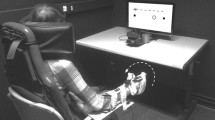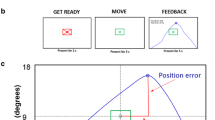Abstract
The current study examined the movement kinematics of older adults when aiming to vertically oriented targets. Late middle-age and early old-age participants completed 20 trials to a small target located downward or upward by 0.16 m from a home position at shoulder height. Aiming direction had a significant effect, resulting in more submovements, which were mostly reflective of undershooting when aiming to the downward compared to upward target. In trials containing a submovement, both groups exhibited shorter total movement time, concomitant with a decrease in duration of the primary movement and an increase in submovement amplitude, when aiming to the downward target. Measures of dispersion also differed in accord with the amplitude of submovements, such that there was greater spatial and temporal variability in the primary movement when aiming in the downward direction. While there was limited evidence of a difference between the groups, there were significant correlations between age and several dependent measures when aiming to the downward target. Of note, in trials containing submovements, older participants exhibited larger amplitude and longer duration submovements, as well as shorter amplitude primary movement. Spatial variability at peak velocity also increased as a function of age when aiming downward, but not in trials without submovements. An explanation related to physical limits on movement production is discounted given the lack of consistent findings between trial types. Instead, we suggest older participants’ exhibit strategic differences in movement kinematics when aiming to vertically located targets, and that these change progressively with age in order to maintain speed-accuracy relations.


Similar content being viewed by others
Notes
As a consequence of not restricting movement to a single axis, it is likely that participants would have lifted the finger away from the screen as they moved off the home position. We verified this by extracting the peak amplitude in movement away from the screen, which for the group was 0.019 m (SD = ±0.013 m). ANOVA on these data indicated a main effect of direction only, with less movement away from the screen evident when aiming downward (0.016 m) compared to upward (0.022 m): F(1,24) = 8.82, P < .01, η p ² = .27.
While the inclusion of submovements associated with a significant deviation in acceleration may have led to a small increase in the total number of identified submovements (Fradet et al. 2008a, b), we opted to use a more conservative approach and thus ensure that we only extracted submovements that were indicative of a clear movement reacceleration.
Note that not all participants exhibited undershoots, and particularly so when aiming to the upward target. Therefore, mean data were calculated from an unequal number of trials, and degrees of freedom reflected the total number of participants who exhibited at least one trial comprising a primary movement followed by a submovement.
References
Bach M (1996) The “Freiburg Visual Acuity Test”—automatic measurement of visual acuity. Opt Vis Sci 73:49–53
Bellgrove MA, Phillips JG, Bradshaw JL, Gallucci RM (1998) Response (re-) programming in aging: a kinematic analysis. J Gerontol A Biol Sci Med Sci 53:222–227
Birren JE (1974) Translations in gerontology: from lab to life. Psychophysiology and speed of response. Am Psychol 29:808–815
Birren JE, Schaie KW (eds) (2006) Handbook of the psychology of aging, 6th edn. Elsevier, San Diego
Chaput S, Proteau L (1996) Aging and motor control. J Gerontol B Psychol Sci Soc Sci 51:346–355
Crevecoeur F, Thonnard J-L, Lefèvre P (2009) Forward models of inertial loads in weightlessness. Neurosci 161:589–598
Elliott D, Hansen S, Mendoza J, Tremblay L (2004) Learning to optimize speed, accuracy and energy expenditure: a framework for understanding speed-accuracy relations in goal-directed aiming. J Mot Behav 36:339–351
Elliott D, Hansen S, Grierson LE (2009) Optimising speed and energy expenditure in accurate visually directed upper limb movements. Ergonomics 52:438–447
Elliott D, Hansen S, Grierson LEM, Lyons J, Bennett SJ, Hayes SJ (2010) Goal-directed aiming: two components but multiple processes. Psychol Bull 136:1023–1044
Folkard S (2008) Shift work, safety, and aging. Chronobiol Int 25:183–198
Fradet L, Lee G, Dounskaia N (2008a) Origins of submovements during pointing movements. Acta Psychol 129:91–100
Fradet L, Lee G, Dounskaia N (2008b) Origins of submovements in movements of elderly adults. J NeuroEng Rehabil 5:28
Gentili R, Cahouet V, Papaxanthis C (2007) Motor planning of arm movement is direction-dependent in the gravity field. Neurosci Lett 145:20–32
Georgiou-Karistianis N, Tang J, Vardy Y et al (2007) Progressive age-related changes in the attentional blink paradigm. Aging Neuropsychol Cogn 14:213–226
Goggin NL, Meeuwsen HJ (1992) Age-related differences in the control of spatial aiming. Res Q Exerc Sport 63:366–372
Guiard Y (1993) On Fitts’s and Hooke’s laws: simple harmonic movement in upper-limb cyclical aiming. Acta Psychol 82:139–159
Ketcham CJ, Seidler RD, van Gemmert AWA, Stelmach GE (2002) Age-related kinematic differences as influenced by task difficulty, target size, and movement amplitude. J Gerontol B Psychol Sci Soc Sci 57:54–64
Khan MA, Franks IM, Goodman D (1998) The effect of practice on the control of rapid aiming movements: evidence for an independency between programming and feedback processing. Q J Exp Psychol 51A:425–444
Lyons J, Elliott D, Swanson LR, Chua R (1996) The use of vision and manual aiming by young and older adults. J Aging Phys Act 4:165–178
Lyons J, Hansen S, Hurding S, Elliott D (2006) Optimizing rapid aiming behaviour: movement kinematics depend on the cost of corrective modifications. Exp Brain Res 174:95–100
Oliviera FT, Elliott D, Goodman D (2005) Energy-minimization bias: compensating for intrinsic influence of energy-minimization mechanisms. Mot Control 9:101–114
Papaxanthis C, Pozzo T, Stapley P (1998) Effects of direction upon kinematic characteristics of vertical pointing movements in man. Neurosci Lett 253:103–106
Papaxanthis C, Pozzo T, Schieppati M (2003) Trajectories of arm pointing movements on the sagittal plane vary with both direction and speed. Exp Brain Res 148:498–503
Papaxanthis C, Pozzo T, McIntyre J (2005) Kinematic and dynamic processes for the control of pointing movements in humans revealed by short-term exposure to microgravity. Neuroscience 135:371–383
Pratt J, Chasteen AL, Abrams RA (1994) Rapid aimed limb movements: age differences and practice effects in component submovements. Psychol Aging 9:325–334
Rabbitt PMA (1979) How old and young subjects monitor and control responses for accuracy and speed. Brit J Psychol 70:305–311
Salthouse TA (1979) Adult age and the speed-accuracy trade-off. Ergonomics 22:811–821
Salthouse TA (2009) When does age-related cognitive decline begin? Neurobiol Aging 30:507–514
Schmidt RA, Zelaznik HN, Hawkins B, Frank JS, Quinn JT (1979) Motor-output variability: a theory for the accuracy of rapid motor acts. Psychol Rev 86:415–451
Teeken JC, Adam JJ, Paas FGWC, van Boxtel MPJ, Houx PJ, Jolles J (1996) Effects of age and gender on discrete and reciprocal aiming movements. Psychol Aging 11:195–198
Walker N, Philbin DA, Fisk AD (1997) Age-related differences in movement control: adjusting submovement structure to optimize performance. J Gerontol B Psychol Sci Soc Sci 52:40–52
Welford AT (1984) Between bodily changes and performance: some possible reasons for slowing with age. Exp Aging Res 10:73–88
Welford AT, Norris AH, Shock NW (1969) Speed and accuracy of movement and their changes with age. Acta Psychol 30:3–15
Welsh TN, Higgins L, Elliott D (2007) Are there age-related differences in learning to optimize speed, accuracy, and energy expenditure? Hum Mov Sci 26:892–912
Worringham CJ (1991) Variability effects on the internal structure of rapid aiming movements. J Mot Behav 23:75–85
Yordanova J, Kolev V, Hohnsbein J, Falkenstein M (2004) Sensorimotor slowing with ageing is mediated by a functional dysregulation of motor generation processes: evidence from high-resolution event-related potential. Brain 127:351–362
Author information
Authors and Affiliations
Corresponding author
Rights and permissions
About this article
Cite this article
Bennett, S.J., Elliott, D. & Rodacki, A. Movement strategies in vertical aiming of older adults. Exp Brain Res 216, 445–455 (2012). https://doi.org/10.1007/s00221-011-2947-x
Received:
Accepted:
Published:
Issue Date:
DOI: https://doi.org/10.1007/s00221-011-2947-x




